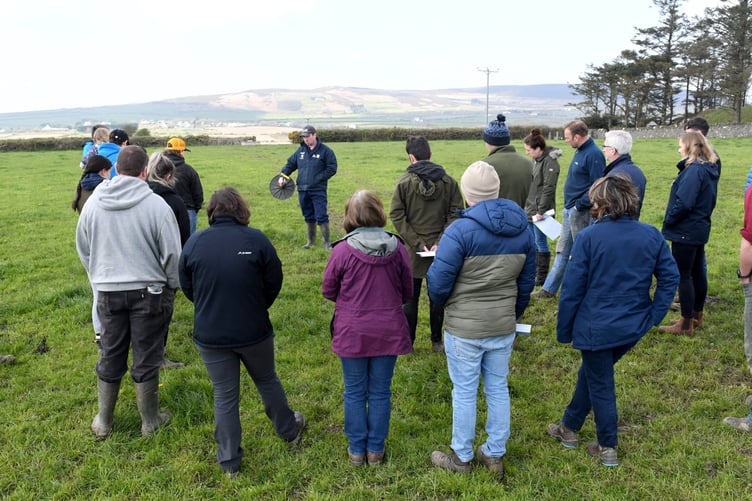The latest ADAS Knowledge Exchange Programme event was held at Ballagawne Farm in Ballabeg recently.
James Dunn and Gillian Preece from ADAS in the UK were presenting a talk, entitled Optimising Grassland.
ADAS, one the UK’s leading agricultural and environmental consultants, has been contracted by DEFA to deliver the four-year knowledge exchange programme, providing face-to-face support on farming and environmental matters, ranging from animal nutrition to carbon auditing.
The programme is an integral part of the agri-environment scheme which changed how active farmers were supported last year with the introduction of targeted funding which encourages actions that boost biodiversity and mitigate climate change.
James is the technical director of ADAS nationally, with a team of consultants, including Gillian, working with him.
He said: ‘The thing here in the Isle of Man is that you’ve got everything the UK has got, but in a smaller space.’
And he acknowledged that Isle of Man farmers do have their own challenges: ‘Without doubt there’s always going to be an added cost here, for example importing specialised dairy feed and exporting products.
‘But the island has got a fantastic branding opportunity with the Biosphere – that’s a huge brand story. It is a fascinating country because of its story.’
When it comes to ADAS’s educational role, he said of the four years : ‘Change is always a difficult word in agriculture. It is so important that we have signed up to a four-year programme on the island because you don’t just come here once and everything changes overnight - you’ve got to change mindsets.’
Last year, they were working with their ‘Developing Farmers’ on the Isle of Man, younger farmers starting out on their own account. They are Chrissie Cannell, Daniel Creer and Alice Foster, and Will Cain.
James said: ‘Last year we also did a lot of soil testing on the island and it showed there was a big issue with lime, so we worked with DEFA to get subsidised lime for farmers and this year the soil is much better.’
Ballagawne, which is farmed by David Cooil and his brother Rob, is, said James, ‘a showcase for what can be done’.
Gillian Preece, who combines her role as an ADAS consultant with helping her husband to run the family farm in south Shropshire, introduced her presentation by saying: ‘Today is all about grassland.
‘Grassland should be treated as any other arable crop should be treated, as it’s a valuable, valuable resource. Grass is the cheapest feed you can ever have on your farm.’
She went on to says that there is a potential to increase output and growth rates in the Isle of Man through optimising grass production, but exponential rises in fertiliser costs have meant farmers here, just as in other parts of the UK are facing a dilemma: do they reduce fertiliser use and then, necessarily, reduce stocking levels?
productivity
Gillian said: ‘It isn’t always about spending less on fertiliser, but increasing the productivity from what you’re already doing. It’s not just about “I don’t want to spend the money”, it’s about spending the money and getting more out of it.’
David and Rob Cooil started to move to a system of rotational grazing in 2012 which works by moving stock around in coordination with the natural growing cycle of grass.
‘Understanding how grass grows is really critical to grass management,’ said Gillian.
Put simply, grass gets grazed and eaten off to ground level then spends the next few days having to go into its reserves to grow again and get the vital first leaf back above ground. It then forms another two leaves and is at peak nutrition.
Rye grass will only ever have three leaves so, when a fourth leaf appears, the first leaf starts to die and the plant starts to lose nutritional value. This cycle takes about three weeks at this time of year when it is actively growing and longer in colder months when it grows more slowly.
‘Graze for three days then give it a break for 21 days is the optimum,’ said Gillian.
In order to know exactly where your grass is up to in this cycle, it is a good idea to measure it. David uses a rising plate meter but you can also use a simple ‘sward measuring stick’ which James was handing out to attendees as we all headed out after the talk to talk a look at David and Rob’s fields and do some measuring.
Compaction, poor soil structure and not enough moisture available can affect growth rates for grass, as can the pH value when soil is be too acid, which is why lime is critical to getting the pH balance right. Weed control is also a factor, to prevent weeds from outcompeting grass
Multi species swards can also help to optimise grassland. These use rye grass as part of a mix which also includes legumes for protein and nitrogen fixing plants such as red clover. They can reduce nitrogen emissions and have deeper roots which make them more resilient to drought.
When the ADAS Knowledge Exchange Programme was launched in the Isle of Man last year, Clare Barber MHK, Minister for Environment, Food and Agriculture, said: ‘This programme is an integral part of our Agri-Environment Scheme, and we hope it will empower active farmers to learn new skills and enable innovation to sustain a vibrant agricultural industry, while enhancing our cherished Biosphere. We also hope this programme can encourage more young people into farming.’
l You can find out more about work ADAS does at adas.co.uk.

.jpeg?width=209&height=140&crop=209:145,smart&quality=75)

.jpeg?width=209&height=140&crop=209:145,smart&quality=75)

Comments
This article has no comments yet. Be the first to leave a comment.